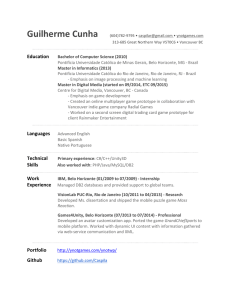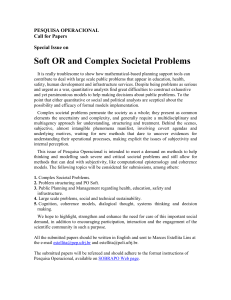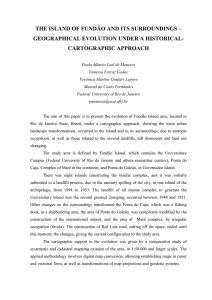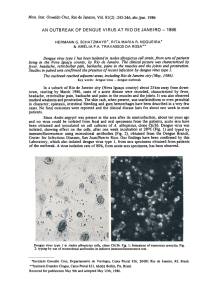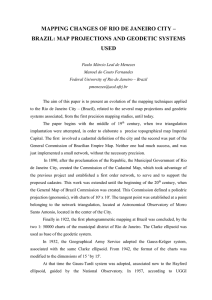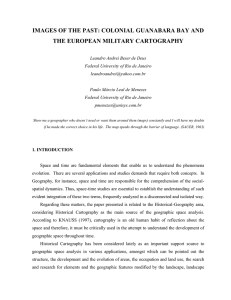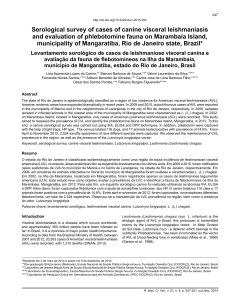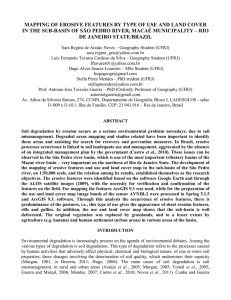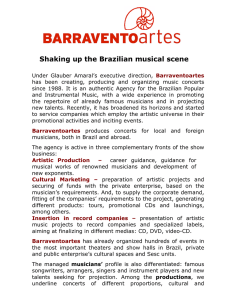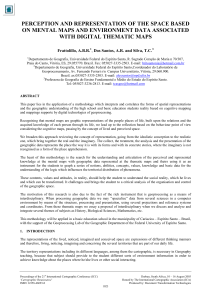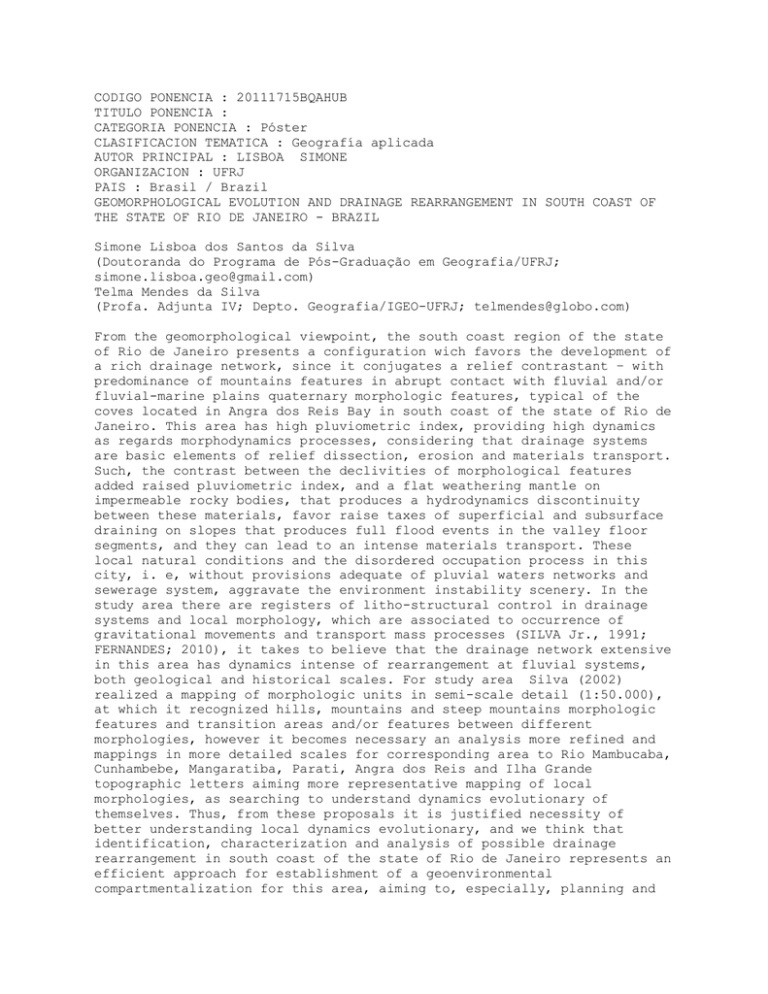
CODIGO PONENCIA : 20111715BQAHUB
TITULO PONENCIA :
CATEGORIA PONENCIA : Póster
CLASIFICACION TEMATICA : Geografía aplicada
AUTOR PRINCIPAL : LISBOA SIMONE
ORGANIZACION : UFRJ
PAIS : Brasil / Brazil
GEOMORPHOLOGICAL EVOLUTION AND DRAINAGE REARRANGEMENT IN SOUTH COAST OF
THE STATE OF RIO DE JANEIRO - BRAZIL
Simone Lisboa dos Santos da Silva
(Doutoranda do Programa de Pós-Graduação em Geografia/UFRJ;
[email protected])
Telma Mendes da Silva
(Profa. Adjunta IV; Depto. Geografia/IGEO-UFRJ; [email protected])
From the geomorphological viewpoint, the south coast region of the state
of Rio de Janeiro presents a configuration wich favors the development of
a rich drainage network, since it conjugates a relief contrastant – with
predominance of mountains features in abrupt contact with fluvial and/or
fluvial-marine plains quaternary morphologic features, typical of the
coves located in Angra dos Reis Bay in south coast of the state of Rio de
Janeiro. This area has high pluviometric index, providing high dynamics
as regards morphodynamics processes, considering that drainage systems
are basic elements of relief dissection, erosion and materials transport.
Such, the contrast between the declivities of morphological features
added raised pluviometric index, and a flat weathering mantle on
impermeable rocky bodies, that produces a hydrodynamics discontinuity
between these materials, favor raise taxes of superficial and subsurface
draining on slopes that produces full flood events in the valley floor
segments, and they can lead to an intense materials transport. These
local natural conditions and the disordered occupation process in this
city, i. e, without provisions adequate of pluvial waters networks and
sewerage system, aggravate the environment instability scenery. In the
study area there are registers of litho-structural control in drainage
systems and local morphology, which are associated to occurrence of
gravitational movements and transport mass processes (SILVA Jr., 1991;
FERNANDES; 2010), it takes to believe that the drainage network extensive
in this area has dynamics intense of rearrangement at fluvial systems,
both geological and historical scales. For study area Silva (2002)
realized a mapping of morphologic units in semi-scale detail (1:50.000),
at which it recognized hills, mountains and steep mountains morphologic
features and transition areas and/or features between different
morphologies, however it becomes necessary an analysis more refined and
mappings in more detailed scales for corresponding area to Rio Mambucaba,
Cunhambebe, Mangaratiba, Parati, Angra dos Reis and Ilha Grande
topographic letters aiming more representative mapping of local
morphologies, as searching to understand dynamics evolutionary of
themselves. Thus, from these proposals it is justified necessity of
better understanding local dynamics evolutionary, and we think that
identification, characterization and analysis of possible drainage
rearrangement in south coast of the state of Rio de Janeiro represents an
efficient approach for establishment of a geoenvironmental
compartmentalization for this area, aiming to, especially, planning and
strategical handling of risks associates to the natural conditions. The
analyses preliminarily carried had allowed to identify the existence of
a bigger number of canals of first and/or zero orders, that can be
articulated to occurrence of recent geomorphological processes and that,
therefore, it contributes as basic information for the understanding of
the current landscape evolution. In this direction, the present work
presents the initial stages of the Doctorate of Geography that aiming to
besides geoenvironmental compartmentalization for study area (considering
litho-structural influence, climate regimen and vegetal covering), it
proposes anomalies drainage identification in 1:50.000 scale, analyzing
neotectonism evidence and using themselves as main evidence for
rearrangements drainage of these systems; through: a) elaboration
topographic and relief profiles, using methodology proposal for Meis et
al. (1982); b) drainage lineaments mapping, which will server for the
analysis and interpretation of the main drainage directions, that crossed
with basement structural directions will allow to verify the geologic
structures influences at morphodynamic; c) morphometric analysis applying
the Factor Asymmetry of the Basin of Drainage (FABD) and Factor of
Transverse Topographical Symmetry (FTTS).
References
FERNANDES, N.F. 2010. Palestra proferida no Seminário “Ilha Grande:
Aspectos Geomorfológicos e Uso/Ocupação do Solo”. Clube de Engenharia –
CREA/RJ. Janeiro de 2010.
MEIS, M.R.; MIRANDA, L.H.G. e FERNANDES, N.F. 1982, Desnivelamento de
altitude como parâmetro para a compartimentação do relevo: bacia do
médio-baixo Paraíba do Sul. In: Congresso Brasileiro de Geologia, 32,
1982, Salvador. Anais... Salvador: SBG. 4:1489-1509.
SILVA Jr., G.C. 1991. Condicionantes Geológicos na Estabilidade de
Taludes ao Longo da Rodovia BR-101 no Trecho Itaguaí – Angra dos Reis.
Rio de Janeiro, 172 p. (Dissertação de Mestrado, Depto. Geologia/IGEOUFRJ).
SILVA, T. M. 2002. A estruturação geomorfológica do Planalto Atlântico no
Estado do Rio de Janeiro. Rio de Janeiro. 2002. 265p. Tese (Doutorado em
Geografia) – Instituto de Geociências, Universidade Federal do Rio de
Janeiro, RJ.

